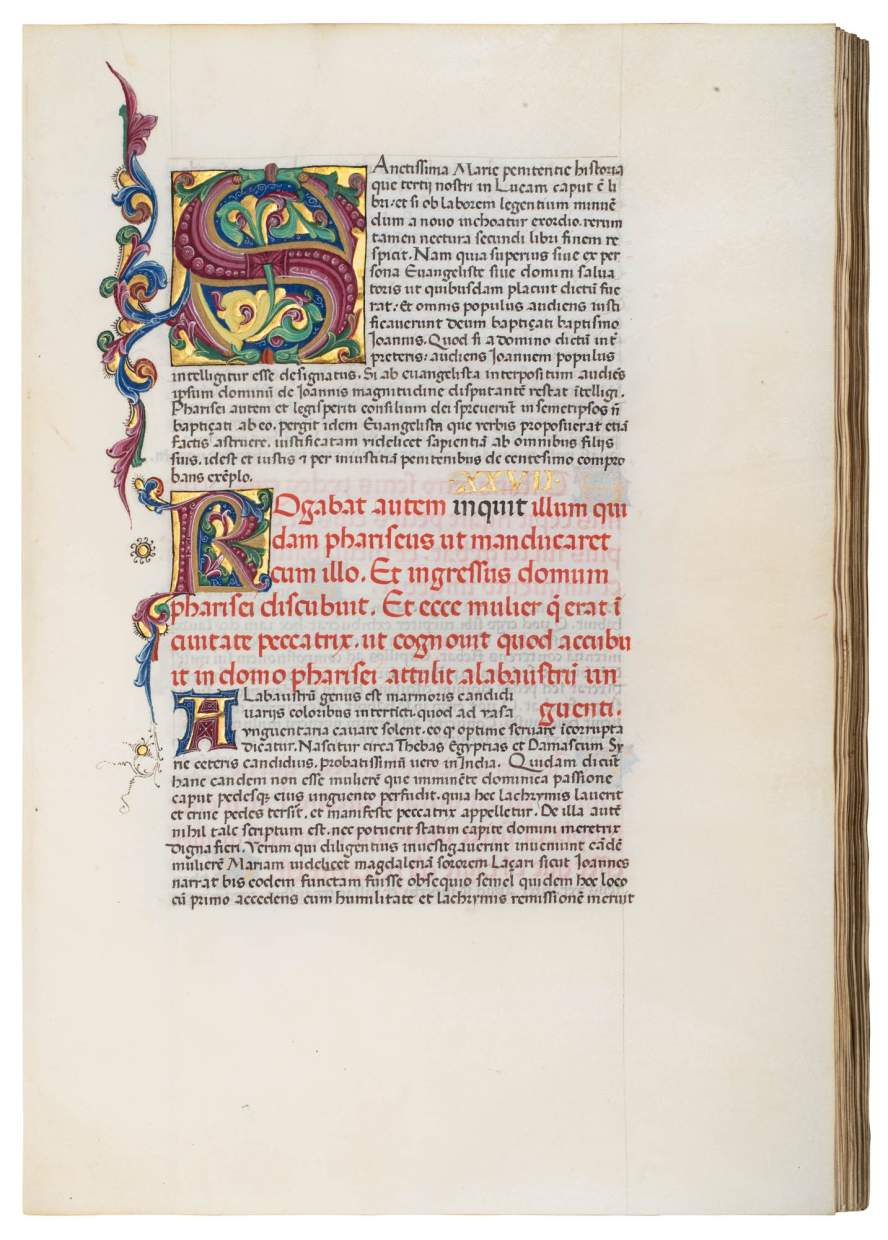Artworks



















This important source recounts the history of the conversion of the Anglo-Saxon tribes to Christianity. During the lifetime of Bede and throughout the Middle Ages, his reputation was mainly based on his scriptural commentaries, such as the one at hand.
Although scholars have identified nearly a hundred manuscripts of Bede on St. Luke and another near-hundred on the Acts of the Apostles, less that a fifth of the extant copies are dated later than the 12th century, and most are Carolingian or early Romanesque. Exemplars of so archaic a text cannot have been easily available in 1480-1481, and similarly, as most Bede manuscripts are so early, they rarely come on the market today. Scholars record no copies of Bede on Acts in private hands and only one outside Europe (Princeton); of Bede on Luke, they cite only two fragments and one volume in America.
However, this codex is not just important because the rarity of this text copied at this late date. It is richly decorated by a talented artist. Seven illuminated initials of up to thirteen lines lie on burnished gold grounds. Intertwined vines and staves, ending in lush acanthus leaves or other vegetal and floral elements, form these extremely decorative letters. Additional dots, curves, and other linear elements in white give each letter a delicate structure and body. Most of these exceptional initials are surrounded by large golden bezants, encircled by rays, or decorated with other ornaments. More than a hundred floral initials with heights of four or five lines are composed in a similar manner with marginal extensions, also often intermingled with gold dots, supporting radiating penwork, or encircling dots in black.
This magnificent secondary decoration and the exquisite hand of the Bohemian scribe recalls a group of theological manuscripts made for the King of Naples in one impressive campaign between c. 1480-1490. The illumination of those manuscripts, including the one at hand, can be attributed to the renowned painter Matteo Felice (1467-1493), who worked for the Royal Library in Naples.
Other manuscripts from the same group are the following:
-
Paris, BnF, ms. lat. 495: St. Thomas Aquinas, Expositio litteralis in Isaiam, signed and dated by the scribe on f. 188r: “Scriptore Venceslao Crispo Bohemo Slagenverdiensi regio sumptu. Neapoli feliciter absolutum. Anno nostre salutis Mo.CCCC.LXXXIX”.
-
Paris, BnF, ms. lat. 674: St. Thomas Aquinas, Expositio in Epistolam Pauli ad Romanos, same scribe, same decoration, but no signature or date.
-
Paris, BnF, ms. lat. 2347: St. Thomas Aquinas, Super tertio libro Sententiarum, signed and dated by the scribe on f. 270r: “Absolutum... scriptoreque Venceslao Crispo Bohemo Anno po4otentisti nativitatem Mill.CCCC.LXXXVI° parum tamen felici impensa inclyti Joannis de Aragonia Ro. ec. card. Exaratum”.
-
Paris, BnF, ms. lat. 2368: St. Bede Venerabilis, In Apocalypto, signed and dated by the scribe on f. 68v: “Venceslaus Crispus, natione Bohemus, e Longobardorum exemplaris transcripsit Anno MoCCCCoLXXX”.
-
Paris, BnF, ms. lat. 6525: St. Thomas Aquinas, Commentaria in libros Aristotelis de celo et mundo et super libros de generatione et corruption, signed and dated by the scribe on f. 294r: “Ferdinandi regis sumptu scriptore Venceslao Crispo bohemo extratus Neapolis anno salutis MCCCCLXXXXIII Idibus augusti".
-
Europe, private collection: St. Thomas Aquinas, Quaestiones potentia dei. Quaestiones de malo, dated by the scribe on f. 376r, explicit “Sicut patet in arreptitiis, and colophon: Questiones de malo beati Thome de Aquino ordinis predicatorum Expliciunt feliciter Anno a Jhesu Christi millesimo quadringentesimo et octagesimo die xxx° Decembris”.



